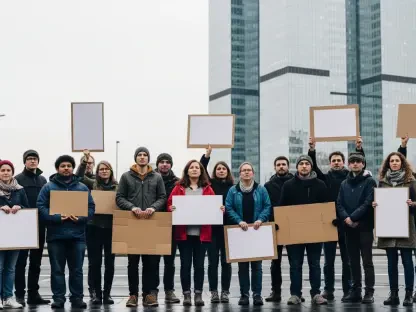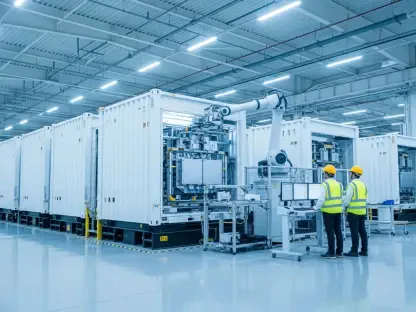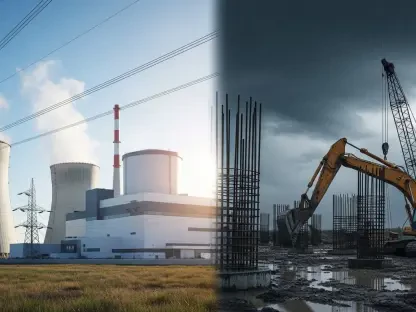Nestled in the vast expanse of Kern County, California, a silent revolution is unfolding under the relentless desert sun, where a $2 billion marvel, the Eland Solar-plus-Storage Center, stands as a beacon of hope amid rising concerns over climate change and energy sustainability. What if a single project could illuminate the path for over 266,000 households in Los Angeles, slashing reliance on fossil fuels while keeping energy bills affordable? This sprawling facility isn’t just generating power—it’s redefining how a major city envisions its future. Dive into the story of how this ambitious endeavor is lighting up LA with clean, renewable energy.
A Desert Powerhouse: Unveiling Eland’s Impact
Deep in Kern County, the Eland Solar-plus-Storage Center emerges as a transformative force in the energy landscape. Spanning acres of sun-soaked land, this facility represents a bold leap toward sustainability for Los Angeles, a city grappling with the dual challenge of growth and environmental responsibility. Operated by Arevon Energy in partnership with the Los Angeles Department of Water and Power (LADWP), the project is more than a power plant—it’s a symbol of innovation in the fight against climate change.
The numbers speak volumes about its significance. With a capacity to power roughly 7% of LA’s energy needs, the center directly impacts hundreds of thousands of residents by delivering clean electricity. This isn’t just about meeting demand; it’s about doing so in a way that aligns with stringent environmental goals, setting a precedent for urban centers nationwide.
Completed in phases, with the first energized in late 2024, the project showcases how strategic planning and investment can yield immediate results. Its presence in the desert isn’t accidental—abundant sunlight and vast space make it an ideal location for harnessing solar energy on a massive scale. This strategic positioning amplifies its role as a linchpin in the city’s renewable energy strategy.
The Urgency of LA’s Clean Energy Drive
Los Angeles stands at a critical crossroads, where escalating energy demands collide with the pressing need to curb greenhouse gas emissions. With a target of achieving 100% clean energy by 2035, the city faces immense pressure to transition away from fossil fuels while ensuring reliability for millions of residents. Projects like Eland are not just helpful—they are essential to meeting these ambitious deadlines.
Climate change adds a layer of urgency to this mission. Rising temperatures and extreme weather patterns underscore the need for sustainable alternatives that reduce carbon footprints. The city’s commitment reflects a broader statewide push in California to prioritize renewable sources, positioning LA as a leader in this transformative movement.
Beyond environmental imperatives, there’s a practical angle to this shift. Energy reliability remains a top concern for urban planners, especially in a metropolis as sprawling as Los Angeles. Balancing growth with sustainability requires innovative solutions, and Eland’s integration of solar and storage technology offers a blueprint for addressing these intertwined challenges.
Inside Eland: Power, Technology, and Potential
At the core of the Eland project lies its impressive technical framework—400 megawatts of solar capacity paired with up to 1,200 megawatt-hours of storage. This dual approach ensures that energy captured during peak sunlight hours can be stored and dispatched when demand spikes, even after dark. Such innovation tackles one of the biggest hurdles in renewable energy: consistency of supply.
Cost-effectiveness further elevates the project’s appeal. At an average of just 4 cents per kilowatt-hour for generation and storage, Eland undercuts many traditional energy sources, translating into tangible savings for LADWP customers. Compared to the higher costs often associated with coal or natural gas, this figure highlights how renewables can be both environmentally and economically advantageous.
The reduction in reliance on dirtier fuels is another key benefit. By supplying clean power to a significant portion of LA’s grid, the facility helps diminish the city’s carbon footprint, aligning with broader climate goals. These metrics—capacity, cost, and environmental impact—combine to illustrate why Eland is a cornerstone of the region’s energy transformation.
Voices of Change: Leaders and Experts Weigh In
City leaders and climate advocates alike have lauded the Eland project as a pivotal achievement. Mayor Karen Bass has described it as a “milestone” that propels LA’s clean energy share beyond 60%, a statistic that reflects real progress toward long-term sustainability targets. Her enthusiasm underscores the project’s role in shaping municipal policy and priorities.
Jonathan Parfrey, Executive Director of Climate Resolve, offers a nuanced perspective on this shift. “What began as a moral imperative to combat climate change has evolved into an economic no-brainer,” he notes, pointing to the growing affordability of renewables like solar compared to fossil fuels. His words capture a changing narrative—clean energy is now a smart financial choice, not just an ethical one.
Arevon Energy, the operator behind Eland, also plays a crucial role in this story. Their expertise in managing large-scale renewable projects ensures operational efficiency, while the collaboration with LADWP through a 25-year power purchase agreement secures long-term benefits for the city. Together, these voices paint a picture of collective ambition driving tangible outcomes.
Lessons from Eland: Building a Sustainable Tomorrow
The success of Eland offers valuable insights for other cities and communities aiming to embrace clean energy. One key takeaway is the importance of long-term commitments, such as LADWP’s 25-year agreement, which provide financial stability and encourage investment in renewables. This model can be replicated elsewhere to ensure sustained progress.
Scalability and affordability stand out as critical factors for evaluating similar initiatives. Communities looking to adopt renewable projects should prioritize solutions that balance environmental impact with economic feasibility, much like Eland does. Advocating for local policies that support such developments can amplify their reach and effectiveness.
Beyond municipal efforts, individual residents can draw inspiration from this project by supporting renewable energy programs or adopting smaller-scale solutions like rooftop solar. Thinking critically about energy choices—whether through community advocacy or personal action—can help replicate Eland’s impact on a broader scale, fostering a culture of sustainability across regions.
Reflecting on a Milestone for LA’s Energy Landscape
Looking back, the completion of the Eland Solar-plus-Storage Center marked a defining chapter in Los Angeles’s journey toward a cleaner energy framework. It demonstrated that large-scale renewable projects could deliver both environmental benefits and economic savings, reshaping perceptions of what was possible. The collaboration between Arevon Energy and LADWP set a high standard for public-private partnerships in this space.
As cities nationwide took note, the project’s influence extended beyond local borders, inspiring a wave of similar initiatives. Moving forward, stakeholders should focus on accelerating the adoption of solar-plus-storage technologies in underserved areas, ensuring equitable access to clean power. Addressing funding gaps and policy barriers will be crucial to scaling these efforts.
Ultimately, the legacy of Eland lies in its ability to spark action at every level—from policymakers crafting supportive legislation to communities championing local projects. Prioritizing innovation and investment in renewables remains the clearest path to a sustainable future, building on the foundation that Eland so powerfully established.









